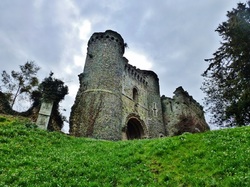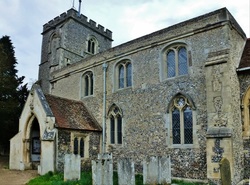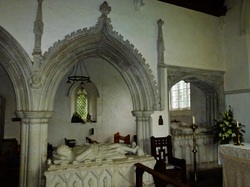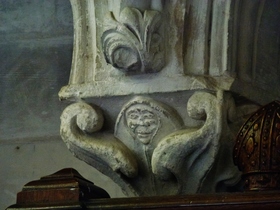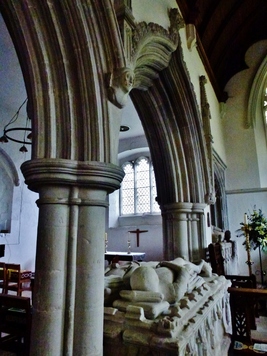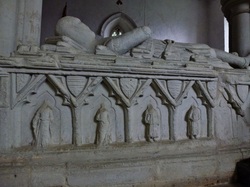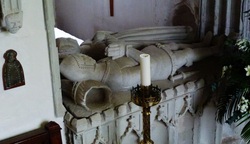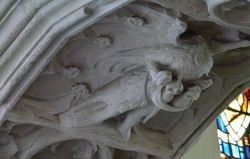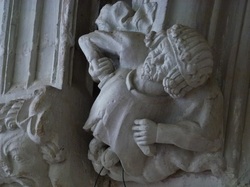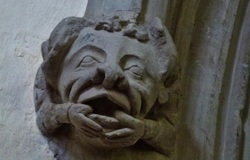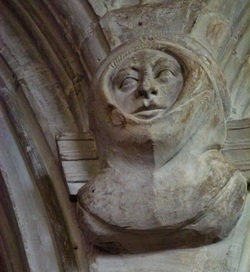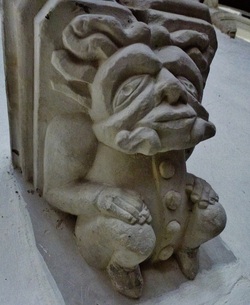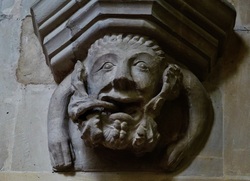St. Peter, Benington.
Faith and folly.
The little village green is surrounded by cottages, whitewashed, half timbered, and weatherboarded, roofed with tile and thatch, a lesson in the vernacular. The road curves past the duck pond and runs down hill beside the embankment of the churchyard , Behind the church rise the stone towers of Benington Lordship, a fantasy castle designed and built by James Pulham of Broxbourne, gardener and inventor of the artificial stone of choice for many a folly and grotto, named somewhat unsurprisingly Pulhamite. His work here fools many people aided by the ruins of a real Norman keep and big earthworks; his flint walled gatehouse and chapel display odd and amusing figurative details in this composite material, which has weathered surprisingly well since 1832 . There’s a dry moat and wet fish ponds, and the parish church stands within the remains of a bailey. The castle gardens are open on occasion, and are well worth a look.
Faith and folly.
The little village green is surrounded by cottages, whitewashed, half timbered, and weatherboarded, roofed with tile and thatch, a lesson in the vernacular. The road curves past the duck pond and runs down hill beside the embankment of the churchyard , Behind the church rise the stone towers of Benington Lordship, a fantasy castle designed and built by James Pulham of Broxbourne, gardener and inventor of the artificial stone of choice for many a folly and grotto, named somewhat unsurprisingly Pulhamite. His work here fools many people aided by the ruins of a real Norman keep and big earthworks; his flint walled gatehouse and chapel display odd and amusing figurative details in this composite material, which has weathered surprisingly well since 1832 . There’s a dry moat and wet fish ponds, and the parish church stands within the remains of a bailey. The castle gardens are open on occasion, and are well worth a look.
The church is a building mostly of the early fourteenth century, though the site is an old one, there having been a palace of the Saxon king of Mercia here in the mid ninth century. Beortwulf was a Christian, and would have had a wooden church within the compound around his great hall. In the spring, the churchyard around the lychgate is a mass of snowdrops. In a niche above the entrance to the porch is the figure of St. Michael killing the dragon, unusual in a church whose patron saint is Peter. The nave has no aisles, but is wide and light, having had a clerestory added over the normal lower windows, presumably when the shallow tie-beam roof was added, with its painted heraldic bosses. There is much good incidental carving in the church too, green men, kings and grotesques of all sorts on niches, roof corbels, window head stops and capitals, and one particularly jolly figure set into the south nave wall. The earliest remains here are of the sedilia in the chancel, with their mid thirteenth century stiffleaf capitals, one inhabited by a hooded man; the cusped arches over the seats and the ogee headed piscina nearby date from early in the next century. The high point of the church is undoubtedly the north east chantry chapel with its monuments, the arches between this and the chancel being designed as canopies to the tombs.
The western arch gives access to the chapel with its windows containing flowing tracery; this and the next arch over the first tomb have multiple complex mouldings carrying finial topped ogee mouldings and pinnacles on quatrefoil piers and well carved figures, including an irate king plunging a sword through his own chest, and large well carved heads on each side of the local lord and his wife.
Below the second arch is an early fourteenth century chest tomb with weepers along the sides and two battered effigies on top, Sir John de Benstede and his wimple-wearing wife Petronilla Moyne, whose portraits are also on the arch above. Enough remains to show that these figures were carved with both zest and sensitivity, the praying mail-clad knight resting his crossed legs on a lion. This was a fashion that post dated most crusades, and had no special meaning. Are these effigies representations of the living, the dead, or the resurrected? Perhaps we shouldn’t expect strict rationality from mediaeval religious concepts, particularly when ideas about purgatory, heaven and hell seem to have been forever in a state of flux.
Below the second arch is an early fourteenth century chest tomb with weepers along the sides and two battered effigies on top, Sir John de Benstede and his wimple-wearing wife Petronilla Moyne, whose portraits are also on the arch above. Enough remains to show that these figures were carved with both zest and sensitivity, the praying mail-clad knight resting his crossed legs on a lion. This was a fashion that post dated most crusades, and had no special meaning. Are these effigies representations of the living, the dead, or the resurrected? Perhaps we shouldn’t expect strict rationality from mediaeval religious concepts, particularly when ideas about purgatory, heaven and hell seem to have been forever in a state of flux.
There is a further archway to the east, cut to take the 1432 tomb of Sir Edward de Benstede and his rich wife Joan Thornbury, and on the soffit above their effigies is carved an angel carrying their souls up to heaven in a napkin. Joan outlived her husband, and her image is more detailed than his, so she probably paid for both after his death. He wears armour and a Lancastrian livery collar, in this case each S is within a circle, but this area is alarmed making it difficult to inspect; I have in the past set such church alarms off, which is not for the faint hearted.
The church is to the south west of the green, and is generally open. The vicar can be contacted on 01763 281218.
The church is to the south west of the green, and is generally open. The vicar can be contacted on 01763 281218.
All rights reserved for this entire site. Copyright reserved to stiffleaf for all text and images, which may not be reproduced without my permission.
